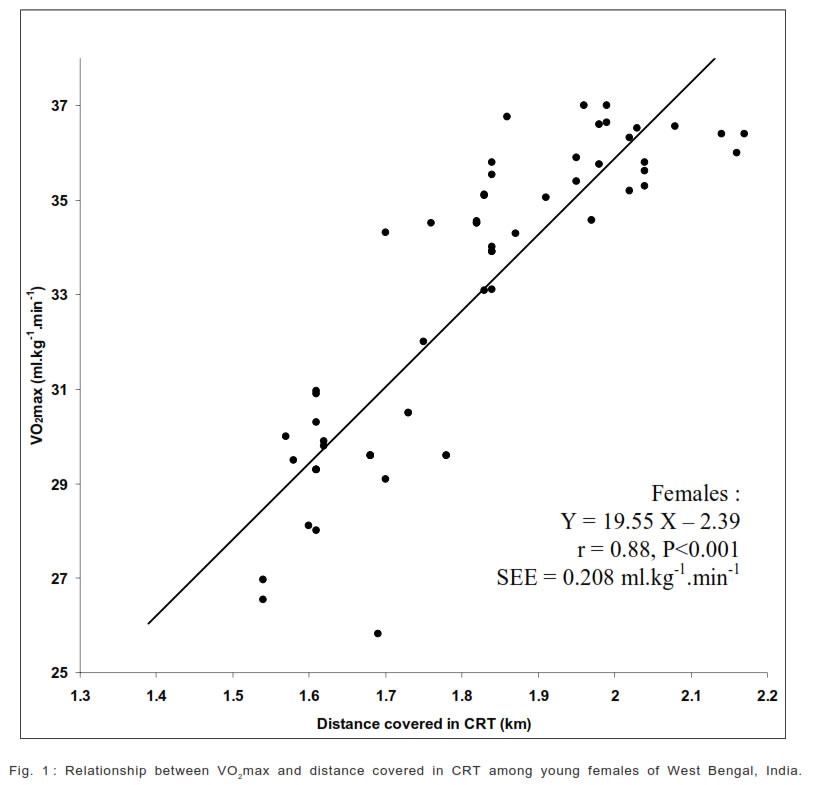and Pharmacology
Indian Journal of Physiology and Pharmacology |
 (252x320).jpg) |
Volume 58 - Number 2 April - 2014 (Current issue) ISSN 0019-5499 |
Validity of Cooper's 12-min Run Test for Estimation of Maximum Oxygen Uptake in Female University StudentsAmit Bandyopadhyay |
Sir, Indirect protocols for determination of maximum oxygen uptake (VO2 max) are often helpful because the direct protocols are exhausting, laborious, complicated and expensive (1). Various indirect protocols exist for prediction of VO2 max but many of them are not yet standardised in Indian context. Cooper's 12 minute run test (CRT) is a popular indirect method of VO2 max estimation and requires only a measuring tape to determine the distance covered in 12 min. The protocol was standardised in Western population and its application in Indian context has not yet been explored. The present study was therefore aimed to assess the suitability for application of CRT to predict VO2 max in female sedentary university students of Kolkata, West Bengal, India. Ninety (90) healthy sedentary female students (20 - 25 years) belonging to similar socio-economic status with mean age, body height and body mass of 22.85+1.69 years, 159.0+4.28 cm, and 52.47+4.17 kg, respectively were selected for the study by simple random sampling from the University of Calcutta, West Bengal, India. They were randomly separated into study group (N=60) on which the existing experimental protocol of CRT was tested and confirmatory group (N=30) on which the modified equation was validated. The entire experimental protocol was well explained to all the participants to allay apprehension and written informed consent was obtained from them. They took light breakfast 2-3 hours before the test and refrained from any energetic physical activity for that period. The participants had no history of any major disease and received no physical conditioning programme except some recreational sports. The whole experiment was performed during September 2012 to February 2013 at a room temperature varying from 26-29°C and at a relative humidity ranging between 72 to 83%. Human Ethical Clearance was obtained from the Human Ethics Committee, Department of Physiology, and University of Calcutta. Maximum oxygen consumption of each subject was
determined by both indirect and direct methods,
respectively, at an interval of 4 days by cross-over
design. Subjects were asked to take rest at least
for half an hour prior to the exercise, so that
pulmonary ventilation and pulse rate could come
down to a steady state (2). Direct estimation of
VO2 max was comprised of incremental bicycle
exercise followed by micro-gas analysis of expired
air (3) whereas indirect estimation of VO2 max
(PVO
max) was conducted by following the protocol
of CRT (4) on a 400 meter round track. Paired t-test,
Pearson's product moment correlation, linear
regression analysis and Bland and Altman approach
for limit of agreement (5) were adopted for the
statistical treatment of the data. Application of this newly derived equation in the confirmatory group revealed insignificant difference between PVO2 max (32.2+2.9 ml.kg-1 .min-1) VO2 max (32.7+3.3 ml.kg-1 .min-1). Moreover the standard error of estimate of this norm was substantially small (SEE = 0.208 ml.kg-1 .min-1). Prediction of VO2 max from this new equation showed a variation of less than 5% in 63 participants, 5-9% in 16 participants, 10-14% in 9 participants and 15-19% in 2 participants from their respective directly measured value of VO2 max. Application of Bland and Altman’s analysis between directly measured VO2 max and indirectly predicted VO2 max from the newly derived equation revealed substantially small limits of agreement in the studied population (-0.26 to 2.46 ml.kg-1 .min-1). The criteria of Test of Repeatability |
 |
Coefficient were also met in the study. The mean differences of repeated measures were 0.0051 ml.kg-1 .min-1 and 0.0045 ml.kg-1 .min-1 for modified equation and direct method, respectively. The corresponding values of Repeatability Coefficients were +0.0363 ml.kg-1 .min-1 and +0.0462 ml.kg-1 .min-1 respectively. From the present observation it may be concluded
that the presently derived or modified equation will
predict VO2
max in the studied population more
accurately. Therefore the newly derived norm is
recommended for application of Cooper's 12 min run test as a valid method for correct and precise
evaluation of cardiorespiratory fitness in terms of
VO2 max in female sedentary university students of
Kolkata, West Bengal, India. |
Author is indebted to the University Grants
Commission, New Delhi for extending financial
assistance to conduct the study. Author also
expresses his heartfelt thanks to the volunteers who
participated in the study. |
|